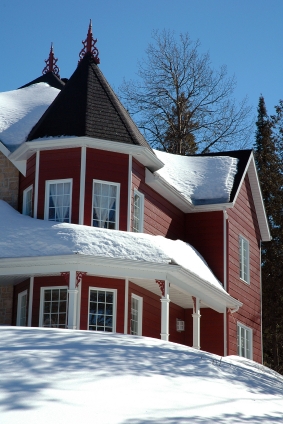 Snow-capped roofs can be quite a sight during winter. As the snow piles up, that pretty sight might lead to problems which could eventually require repair. It is important to identify potential problems that could occur and then be prepared to handle or possible prevent them.
Snow-capped roofs can be quite a sight during winter. As the snow piles up, that pretty sight might lead to problems which could eventually require repair. It is important to identify potential problems that could occur and then be prepared to handle or possible prevent them.
Problems
While the roof is designed to be a sturdy structure, it can encounter a myriad of problems during winter. The combination of cold weather and constant snowfall is something that cannot be overcome through mechanical means alone. Following are some roof-related problems that could happen during harsh winter weather.
- Ice Dams – Ice damming is a condition when water pools at the edge of a roof due to a combination of insufficient insulation and ice build-up. This happens because heat within the living space escapes into poorly-insulated attic areas, causing ice or snow to melt. When the water reaches the end of the roof, it encounters very cold gutters which causes the water to re-freeze, eventually creating a layer of ice or dam that actually blocks water movement into and through the gutters, creating standing water on the roof. This standing water eventually finds its way through cracks or small holes into the underlayment, damaging underlying material. This condition is most common on low slopes where water does not easily run off.
- Excess Weight – While snow is lighter than ice, a continuous cycle of melting and freezing can create ice, which is heavier and harder. While an actual cave-in rarely happens, the compounded weight can put enough stress on the structure to cause it to bend, opening gaps and creating cracks where water can seep through.
- Icicles – Snow can also fill up the gutters, making them useless for collecting water run-off. Instead, run-off water drips off the edge of the gutter and forms icicles.
Inspections
Before winter arrives, it is important to prepare for the season. An inspection should be done during the fall to allow enough time to perform any necessary repairs. This inspection should focus on finding any critical areas that could be a passageway for leaks. Professional contractors often use infrared imaging where leaks are more evident due to the difference in the heat signature.
Prevention
Remove thick layers of snow from the top of the structure to prevent them from becoming compacted. Relieving this weight can prevent cracks from forming in the underlayment and decking. Heat cables can be installed along the gutter to prevent the formation of ice dams.
In areas where constant shoveling cannot keep up with the rate of snowfall; a hydronic snowmelt system may be installed. Basically, this is a heating system that is designed to melt snow off the roof in order to prevent it from piling up. Heat is generated from the device’s boiler and transmitted to a heating element located on the roof.
Snow may not seem as if it would be as damaging as hail or strong wind; however, if not properly managed it can cause just as much damage. Hopefully this article has provided some helpful information regarding the effects that snow has on a roof and how it can be effectively managed!
Contact Schulte Roofing for Houston Roofing Repair!
Do you need to find a Houston roofing repair company who can help you prepare your roof for the harsh winter snow? Call Schulte Roofing at 800-367-7663 who can help customers in the greater Houston area with this and all roofing needs!
